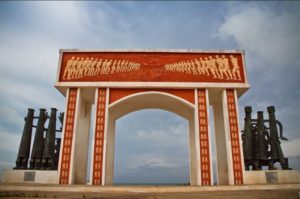Although Ghana officially launched the Return to Africa project last year, the history of Africans in the diaspora returning to the Mother Continent goes back two centuries. Kwaku examines the historical records to chart this movement.
With Ghana’s President Nana Akufo-Addo having personally launched The Year of Return (TYOR) project in Washington DC last autumn, Ghana is poised to be the number one destination for African- Americans and other diaspora Africans in 2019. However, as we shall see, there’s a long history of Africans returning to Ghana and other African countries.
TYOR’s year-long activities include concerts, a carnival and an investment summit, as well as history, youth, cultural and Pan Africanism programmes. Although the project aims to attract mainly diaspora Africans, including second-generation Ghanaians, from all parts of the world, the focus is heavily tilted towards African- Americans. The reason being that this year marks the 400th anniversary of the landing of the first recorded arrivals of Africans in what is now the United States. The status of the 20 trafficked Africans who arrived on a Spanish ship at Jamestown, Virginia in 1619 is still debated.
As chattel enslavement had not yet officially begun in England’s North American colonies, the speculation is that the Africans were either enslaved or indentured workers, or a mixture of both. But within fifty years, chattel enslavement had become legalised in Virginia and other states, and particularly in the southern states, chattel enslavement was to become the key driver of the plantation economies that flourished well into the late 19th century.
The insatiable need for enslaved Africans meant millions of Africans were trafficked from Africa across the Atlantic to plantations in the Caribbean and both North and South America, which resulted in significant African diasporas in the so-called New World. Nominal emancipation of Africans in this region came over a long period. In 1793, the Africans in Haiti became the first to be emancipated, and on 1 January 1804, they declared Haiti an enslavement-free republic, following the African-led Haitian Revolution of 1791-1804. In 1838, the Africans in the British Caribbean were emancipated. The 1833 Slavery Abolition Act only freed Africans aged up to six in 1834 (the servitude of slaves over six being abolished in two stages). The last of the Latin American countries to abolish enslavement were Cuba in 1886 and Brazil in 1888.
Early returnees Brazil, which today has the largest African population outside of Africa, provided one of the earliest and largest volumes of returnees. The earliest returnees from Brazil to West Africa include some of those who took part in the January 1835 Malê revolt, also known as The Great Revolt. During the 19th century, thousands of free and enslaved Africans emigrated from Brazil to present-day Nigeria, Benin, Ghana and Togo. These Afro-Brazilians, known as Tabom people, integrated into their West African local societies, swapped Portuguese for the English and French lingua franca, and indigenous languages.
Today, it’s their surnames, such as de Souza, Peregrino or Plange, that tell of their Brazilian sojourn. My maternal lineage comes from the Ghanaian Tabom people, and at the time of writing, my daughter is back in Brazil researching the Tabom history for a documentary film. Thanks to Steven Spielberg’s 1997-directed film Amistad, many people know the story of the returnees from Cuba. The film tells the historical story of the enslaved Africans who took over the ship La Amistad, which was transporting them from Havana, Cuba to their owners’ US plantations in 1839.
The Africans, who were Mende people from Sierra Leone, spared a few of the European ship’s crew and ordered them to sail to Africa. To cut a long story short, the remaining crew had no intention of sailing to Africa, and with the 53 Africans not having any nautical experience, the ship zig-zagged across the Atlantic for 63 days until it entered US waters, whereupon the US naval authorities arrested the ship on 26 August 1839. The owners of the ship and the Spanish government asked for the return of the enslaved Africans.
However, it wasn’t a simple matter, on account of the US having abolished the trafficking of Africans in 1808. The US abolition campaigners who fought for the freedom of the imprisoned Africans finally triumphed in the 1841 United States v. The Amistad case, where the US Supreme Court found in favour of the Africans. With their free status established, the 35 surviving Africans returned to Sierra Leone in January 1842, along with five missionaries and teachers who formed a Christian anti-enslavement mission in the British colony.
Another significant returnee chapter involves the Africans, free and enslaved, who fought on the side of the British in the 1775–1783 US War of Independence. The latter were promised their freedom at the end of the war. Known as the Black Loyalists, thousands of them were initially decamped in Nova Scotia, Canada, whilst others were sent to England, many of whom, along with other Africans living in London, became known as the Black Poor.
From 1787, when the Sierra Leone resettlement programme started, thousands of Black Loyalists from Nova Scotia and the Black Poor from London were resettled in Sierra Leone. They are the ancestors of today’s Creole people of Sierra Leone. In December 1815, Paul Cuffee (he adopted his father’s first name Kofi as his surname), a freeborn African Massachusetts-based merchant, ship owner and captain, set sail with the first batch of free Africans to emigrate to Sierra Leone from the US.
However, it was to Liberia that the majority of Africans from the US, and some from the Caribbean, returned throughout the 19th century. This back to Africa movement was led by organisations such as the American Colonisation Society, which helped relocate thousands of free African-Americans in Liberia, partly as a means of countering the chattel enslavement and overt racism in the US. Since the publication of Alex Haley’s book Roots in 1976, which was followed by the television series of the same name, AfricanAmericans and African-Caribbeans have had an affinity with the Senegambia area.
Indeed, quite a few African-Caribbean people have relocated to Gambia, whilst many more either attend the biennial International Roots Festival (formerly Homecoming), support or build community projects, such as schools. Interestingly, in 1948, 50 years before TYOR was launched, Emperor Haile Selassie donated land in Shashamane, Ethiopia to members of the then newly developing Rastafari movement in Jamaica, and all African-Caribbean people, for them to return to.
On his tour of the Caribbean in 1966 – he visited Barbados, Trinidad, Haiti, and Jamaica – the Emperor reiterated his call for repatriation to Ethiopia. That visit helped accelerate the resettlement programme, with a few thousand Africans, mostly Jamaicans, relocating to Shashamane. Transatlantic links On 6 March 1957, when Ghana became independent, Prime Minister Kwame Nkrumah declared: “Our independence is meaningless unless it is linked up with the total liberation of Africa.”
In true Pan-African style, Nkrumah brought Trinidadian-born political activist, George Padmore to Ghana, where he was given oversight of the African Affairs bureau. Although he died in London, where he went for medical treatment, Padmore’s ashes were buried in Accra on 4 October 1959. The grand old Pan-Africanist, W.E.B. Du Bois also relocated to Ghana and died in Accra on 27 August 1963 as a Ghanaian citizen. Last November I organised an event in London called #HostileEnvironment? Look To Africa! It was a forum for exploring options, including either investing in, or relocating to Africa at a time when there is a hostile immigration policy in Britain, which was exposed by last year’s Commonwealth/ Windrush scandal.
There were contributions from a London-born woman of Ghanaian parentage who had recently relocated to Ghana, and an African-American family who had done the same. The latter, known as the Native Borne Family, produce travelogues on Youtube which provide practical advice on living in Ghana for visitors and returnees. As we can see, there is a long history of diaspora returnees relocating to Ghana, where laws have been enacted to assist the process.
The 2000 Immigration Act provides diaspora Africans with a Right of Abode status, which means they have an indefinite right to live and work in the country permanently, without facing the need for visas or any other restrictions. Additionally, the 2000 Citizenship Act allows diaspora Africans to apply for Ghanaian citizenship. A cohort of 34 people, mainly from the Caribbean, was the first to receive citizenship certificates, in 2016.
Finally, in 2007, at a time when Britain was commemorating the bicentenary of the 1807 Abolition of the Slave Trade Act, I met an African-Caribbean woman in London. She said she’d never describe herself as African, because no one came from Africa to the Caribbean to look for her ancestors and take them back after enslavement was abolished. One could however argue that in light of those who had come before her, she could have also come back. Certainly in 2019, the doors are open in Ghana and elsewhere for such trips.
Kwaku is a London, UK-based history consultant.
–
Credit: newafricanmagazine.com




